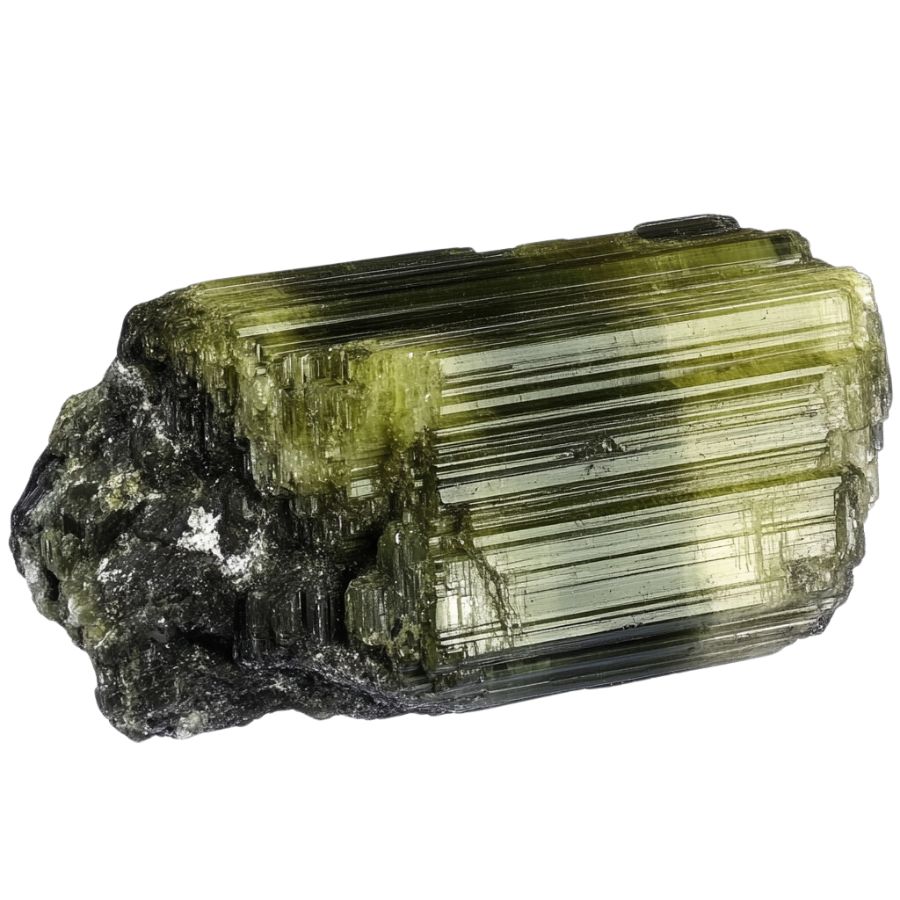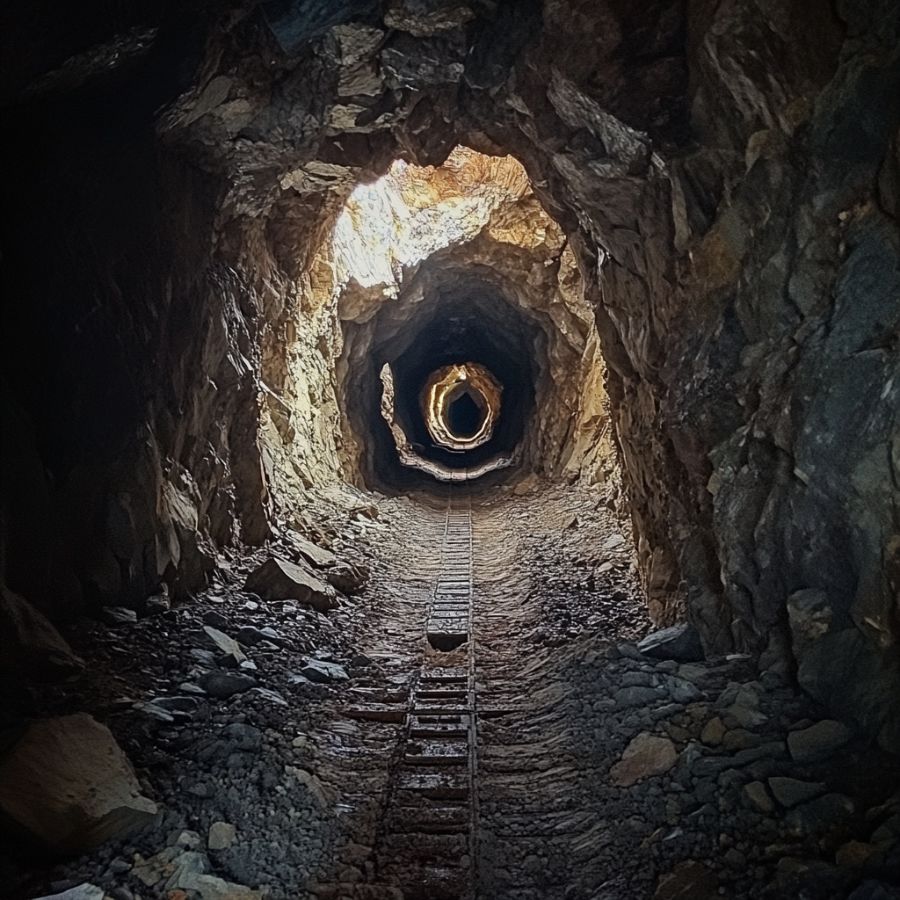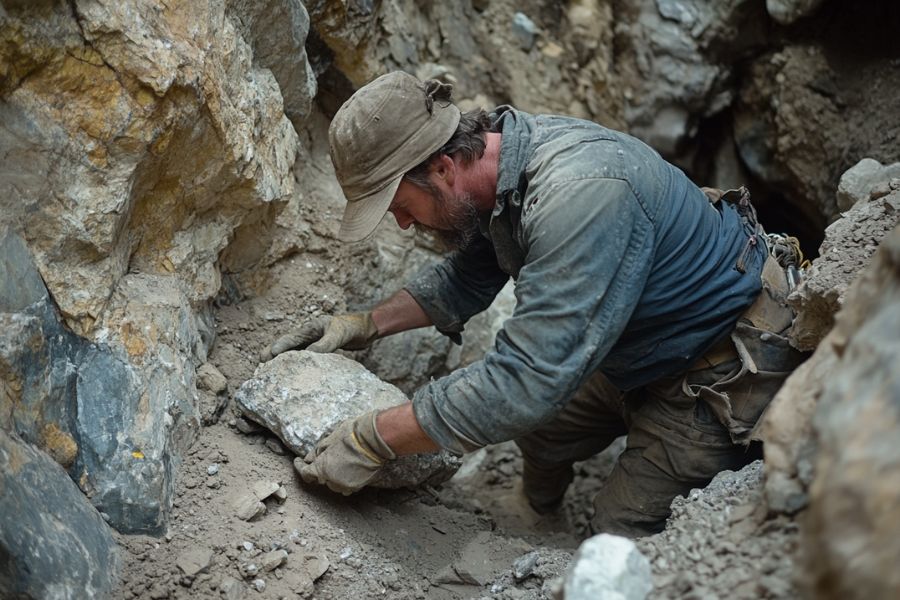From the Appalachian Mountains to the Atlantic Ocean, from the Chattahoochee River to the Savannah River, Georgia offers a treasure trove for rockhounds.
But finding tourmaline in such a big state can be frustrating and time-consuming. You might spend hours searching only to come up empty-handed.
Don’t worry! We’ve done the hard work for you. We will show you the 52 prime locations for discovering tourmaline in the Peach State.
We’ve sourced the best spots to save you time and energy. No more aimless wandering or fruitless searches.
Get ready to uncover Georgia’s hidden gems with our expert guide to tourmaline hotspots.
How Tourmaline Forms Here

Tourmaline forms deep underground through intense heat and pressure. It originates from hot, mineral-rich fluids that move through fractures in rocks like granite and pegmatite. As these fluids cool, the minerals within them start to crystallize, forming tourmaline.
The color of tourmaline depends on the specific minerals involved, leading to a wide range of hues including pink, red, green, and blue.
Over millions of years, these crystals grow and become the beautiful, multifaceted stones we see today. Tourmaline is prized for its variety of colors and is often used in jewelry and decorative items.
The Types Of Tourmaline
Several incredible types of Tourmaline can be found in the US as well as in our state. Each is uniquely beautiful and interesting including:
Elbaite

Elbaite is found in pink, red, green, blue, yellow, and even colorless forms. What makes elbaite special is its ability to show multiple colors in a single crystal, like the famous “watermelon” tourmaline with pink and green hues.
This gem stands out due to its complex chemical makeup, which includes lithium, sodium, and aluminum. This composition gives Elbaite its diverse color range and dichroism, allowing it to display different colors when viewed from different angles.
Elbaite has a unique place in history as the first tourmaline variety in which lithium was discovered back in 1818. Some rare types, like the neon blue Paraiba elbaite, are highly sought after by collectors and jewelers.
Schorl

Schorl is known for its deep, rich color. It typically forms long, prismatic crystals with a shiny, glass-like surface when polished. Unlike other tourmalines, schorl gets its distinctive black color from high iron concentrations.
One of Schorl’s most fascinating features is its ability to become electrically charged through heating or rubbing. When charged, it can attract or repel small particles.
This unique electrical property makes Schorl valuable in various industries. It’s used in electronics and manufacturing to control static electricity and electromagnetic interference.
Despite being less colorful than other tourmalines, schorl’s practical applications make it an important and interesting variety.
Rubellite

Rubellite stands out with its vibrant pink to red colors. The most prized ones show a pure, saturated red without any brown or orange hints. This beautiful color comes from manganese in its makeup.
One cool thing about rubellite is its double refraction. It can look like it has two different colors when you view it from different angles.
Dravite

Dravite, or Brown Tourmaline, comes in shades from dark brown to light brown-yellow. It can look a bit like Smoky Quartz, with a semi-see-through quality.
Its crystals are often needle-like or prismatic, with points at both ends. This sets it apart from other tourmalines like the darker schorl or the colorful elbaite.
What makes dravite special is its rich sodium and magnesium content. This sets it apart from other tourmalines. It was first discovered in 1883 and named after the Drava River in Slovenia.
Indicolite

Indicolite is a rare and captivating blue to blue-green stone. It’s prized for its pure, bright blue color, which is considered the rarest within the tourmaline family. The hues can range from light blue-green to deep, rich blue, often with high clarity.
What sets Indicolite apart is its unique optical effects. It shows pleochroism, appearing to change color when viewed from different angles. Some specimens also display chatoyancy, creating a “cat’s eye” effect when cut in a certain way.
Indicolite is sometimes called “Brazilian sapphire” due to its resemblance to the precious gem. However, they’re different minerals.
The increasing demand for blue tourmalines has made indicolite highly sought-after in the gemstone market, appreciated for its beauty and rarity.
Watermelon Tourmaline

Watermelon tourmaline is truly one-of-a-kind. It looks just like a slice of watermelon, with a pink or red center and a green outer layer. This unique look happens because different elements join the crystal at different times as it grows.
These crystals often form in a rounded triangle shape. They’re see-through to somewhat clear and have a glass-like shine. When cut into slices, they really do look like little watermelons!
Cat’s Eye Tourmaline

Cat’s eye tourmaline is known for its mesmerizing chatoyancy effect. This creates a bright band across the stone’s surface, resembling a cat’s eye.
This stone comes in various colors, from green to pink to brown, and is usually semi-translucent to opaque.
What makes this stone special is the perfect alignment of tiny, needle-like inclusions inside it. These scatter light in a unique way, creating that eye-catching effect. It’s quite different from other tourmalines that don’t have this feature.
Unlike other cat’s eye stones, Tourmaline offers a wider range of colors and is often more affordable.
Achroite

Achroite is a rare, colorless variety of tourmaline that looks like a drop of clear water turned to stone. It’s completely transparent, making it unique among tourmalines which usually have color. The name comes from Greek, meaning “without color.”
What’s special about achroite is that it doesn’t change color when viewed from different angles. It means the stone can be cut in many ways without losing its clarity.
Verdelite

Verdelite is known for its beautiful green color. It can range from light green to deep emerald.
One thing that makes verdelite special is that you can find big, clear crystals of it. This isn’t always easy with other gemstones.
People love using verdelite in jewelry because its rich color and interesting light effects make it a popular choice for all kinds of accessories. Each piece of verdelite is like a little piece of nature you can wear.
Paraíba Tourmaline

Paraíba Tourmaline is a rare gemstone that catches the eye with its vibrant neon blue or green color. It’s like no other tourmaline you’ve seen before. The intense glow comes from copper in the stone, making it stand out from its cousins.
This stone is one of the rarest. For every 10,000 diamonds mined, only one Paraíba tourmaline is found.
It was only discovered in the late 1980s, making it a newcomer in the gem world. But Paraíba tourmaline’s unique color and rarity quickly made it a favorite among gem lovers.
Its discovery caused quite a stir in the gem community. Even small stones can be valuable because of how rare and beautiful they are.
What Rough Tourmaline Looks Like
When you’re out looking for rough Tourmaline on your own it’s important to know what you’re looking for. Here are some tips to help you recognize rough tourmaline.
Look for Color Variations

Tourmaline comes in many colors, like pink, green, blue, and even black. Some pieces have multiple colors, like watermelon tourmaline, which is pink and green.
If you see these color mixes, it’s likely tourmaline. Keep an eye out for vibrant shades.
Assess the Density and Weight

Rough tourmaline is relatively heavy for its size. If you pick up a piece and it feels denser than expected, it could be tourmaline. This weight can help you confirm your find.
Examine the Crystal Structure

Tourmaline features distinctive crystal shapes, ranging from slender and elongated to chunky forms. Look for triangular cross-sections and striations on the surface, which indicate its unique growth patterns.
Check for Transparency

Some rough tourmaline can be slightly transparent. If you hold it up to the light, you might see through it a bit. This transparency can be a good sign that you have tourmaline.
A Quick Request About Collecting
Always Confirm Access and Collection Rules!
Before heading out to any of the locations on our list you need to confirm access requirements and collection rules for both public and private locations directly with the location. We haven’t personally verified every location and the access requirements and collection rules often change without notice.
Many of the locations we mention will not allow collecting but are still great places for those who love to find beautiful rocks and minerals in the wild without keeping them. We also can’t guarantee you will find anything in these locations since they are constantly changing.
Always get updated information directly from the source ahead of time to ensure responsible rockhounding. If you want even more current options it’s always a good idea to contact local rock and mineral clubs and groups
Tips on where to look
Once you get to the places we have listed below there are some things you should keep in mind when you’re searching:
Look for Sedimentary Rocks

Sedimentary rocks are great places to find tourmaline. These rocks form from layers of sand, mud, and minerals. Over time, minerals like tourmaline can get trapped.
Look in riverbeds or areas where sediment has built up. You might find small pieces or even larger crystals.
Explore Mines

Mines are great spots to find tourmaline. Many mines across the U.S. extract various gemstones, including tourmaline.
Some mines even allow visitors to search for gems themselves. Always check if they have guided tours or special digging days.
Search in Gravel Pits

Gravel pits are often overlooked, but they can be treasure troves. These pits dig deep into the earth, exposing layers of rock.
Tourmaline can be found in the gravel. Just sift through the material carefully.
The types of Tourmaline can you find around the state
Georgia is primarily known for its deposits of black tourmaline, also called schorl. This variety of tourmaline is the most common type found in the state and is characterized by its dark, almost jet-black color.
While black tourmaline dominates the tourmaline scene in Georgia, other colors may occasionally be found, though they are much rarer. These can include green, pink, or blue tourmaline, but such discoveries are infrequent.
Some Great Places To Start
Let’s dive into Georgia’s top tourmaline hunting grounds. These locations offer the best chances for finding this sought-after gemstone in the Peach State.
Always Confirm Access and Collection Rules!
Before heading out to any of the locations on our list you need to confirm access requirements and collection rules for both public and private locations directly with the location. We haven’t personally verified every location and the access requirements and collection rules often change without notice.
Many of the locations we mention will not allow collecting but are still great places for those who love to find beautiful rocks and minerals in the wild without keeping them. We also can’t guarantee you will find anything in these locations since they are constantly changing.
Always get updated information directly from the source ahead of time to ensure responsible rockhounding. If you want even more current options it’s always a good idea to contact local rock and mineral clubs and groups
Sweat Mountain

Nestled in the suburbs north of Atlanta, Sweat Mountain rises as the second-highest point in Georgia. This 1,688-foot peak, part of the Appalachian Mountains, is a hidden gem for rockhounds seeking tourmaline.
Sweat Mountain’s natural rock formations, including a unique rock shelter, offer exciting opportunities for tourmaline hunting. The northern side of the summit is particularly promising, with its exposed rock faces potentially hiding colorful tourmaline crystals.
While exploring, keep an eye out for the mountain’s historic radio transmitters and antennas, remnants of its past as a communication hub.
These structures stand as silent witnesses to the area’s technological history, adding an intriguing backdrop to your gemstone adventure.
Creeks and gravels around the mountain’s base might also yield tourmaline finds, especially after rainfall when stones are freshly exposed.
Etowah River

The Etowah River winds its way through the southern slopes of the Appalachian Mountains. This scenic waterway, originating near Dahlonega, is a treasure trove for rockhounds.
The river’s unique geology, shaped by ancient mountain-building events, creates an ideal environment for finding tourmaline and other gemstones.
Gravel bars along the Etowah are hotspots for gem hunters. These areas accumulate mineral-rich sediments washed down from the mountains.
Look for dark, prismatic crystals of tourmaline mixed in with the river rocks. The best hunting is often after heavy rains when fresh material is exposed.
The river’s history adds to its allure. Native Americans once panned for gold here, and remnants of old mining operations can still be seen.
Today, the Etowah offers more than just gems. Its waters are home to diverse wildlife, including the rare Etowah darter fish, making your gem-hunting adventure a chance to experience Georgia’s natural beauty up close.
Yahoola Creek

Nestled in the picturesque Chattahoochee-Oconee National Forest, Yahoola Creek winds through Dahlonega, offering a treasure trove for rockhounds.
This historic stream, once at the heart of America’s first major gold rush, now attracts gem enthusiasts seeking colorful tourmaline. The creek’s rich geological tapestry, shaped by centuries of erosion, creates ideal conditions for unearthing these prized crystals.
Rockhounds can explore the creek’s gravelly banks and shallow waters, where tourmaline often hides among the sediment.
The best spots are typically just downstream from the Lake Zwerner dam, where the water’s flow exposes fresh deposits. Autumn is prime hunting season, as lower water levels reveal more of the creek bed.
Beyond gemstones, Yahoola Creek offers a glimpse into Georgia’s mining heritage. Old sluice boxes and mining equipment still dot the landscape, serving as reminders of the area’s golden past and adding an extra layer of excitement to your tourmaline hunt.
Marble Hill

Marble Hill in Pickens County, Georgia, is a great place to hunt for tourmaline. This small community is known for its pink marble, which you can see in many old buildings.
The area’s rich geological tapestry includes a variety of minerals like gold, mica, and copper, making it a prime spot for gemstone enthusiasts.
Tourmaline has been discovered here, adding to the area’s allure for gem hunters. The best places to search are often in the gravels and creeks around the old quarries. These water-worn areas can reveal hidden treasures.
The Tate House, a local landmark built from the area’s distinctive pink marble, stands as a testament to the region’s geological wealth. This same marble was used in notable buildings across the country, including the Lincoln Memorial.
Hogg Mine

Hogg Mine is a fee-to-dig site, open to the public, and is famous for its rich pegmatite deposits. The mine’s unique geology creates an ideal environment for forming various minerals, including tourmaline.
Hogg Mine’s pegmatite is known for its lensoidal graphic granite structure, separated from a rose quartz core by a narrow replacement zone. This formation has produced impressive large crystals of beryl, particularly aquamarine.
Rockhounds often find success sifting through the mine’s gravels and tailings, where tourmaline and other gems hide.
Besides tourmaline, the site yields an array of minerals like rose quartz, muscovite, and beryl. The diverse mineralogy makes each dig an exciting treasure hunt.
Visitors should come prepared with proper tools and expect to get their hands dirty while exploring this geological wonder.
Places tourmaline has been found by county
Beyond our top recommendations, we’ve compiled a comprehensive list of additional tourmaline hotspots in Georgia. To make your search easier, we’ve organized these locations by county.
| County | Location |
| Barrow | Winder Area |
| Camden | Cabin Bluff deposit |
| Charlton | Folkston West Deposit |
| Cherokee | Reevis mica prospect in Ball Ground Area |
| Cherokee | South Amphlett prospect |
| Clarke | Railroad cut in Athens |
| Dawson | Dawsonville Area mines |
| DeKalb | Consolidated Quarries |
| DeKalb | Ethel quarry |
| DeKalb | Flat Rock Quarry |
| DeKalb | Hayne Quarry |
| DeKalb | Kellogg Quarry |
| DeKalb | Powell quarry |
| DeKalb | Venable Estate Quarries |
| Elbert | Cold Water Creek |
| Fayette | Porter Prospect |
| Habersham | Cove Branch in Batesville |
| Habersham | countywide in the roadcuts |
| Jackson | Jefferson Area |
| Lamar | Means prospect |
| Lincoln | Dry Fork Creek |
| Madison | countywide in the gravel pits and creeks |
| Paulding | Lots 612 & 649 |
| Pickens | Fowler & Freeman Prospects |
| Pickens | James Foster prospect in Marble Hill |
| Rabun | Laurel Creek complex |
| Rockdale | Almond Quarry |
| Spalding | T.J. Allen Prospect |
| Spalding | rocky outcrops of Griffin Area |
| Stephens | Draws, flats, canyon gravels in the Avalon Area |
| Towns | countywide across the roadcuts and in creeks |
| Troup | pegmatite outcrops near LaGrange Airport |
| Troup | pegmatite outcrop from dirt rd. to Grady Hill School in LaGrange |
| Troup | in a pegmatite on W side of Rte. 219 in LaGrange |
| Troup | Louise Chromite belt |
| Troup | Louise Chromite Deposit |
| Troup | Word prospect |
| Union | Gumlog Mountain |
| Upson | Walker Prospect |
| Walton | George Felker farm |
| Lincoln | Graves Mountain |
| Wayne | Amelia Deposit |
| De Kalb | Rock Chapel Quarry |
| De Kalb | Lithonia Area |
| Lumpkin | Turkey Hill |
| De Kalb | Arabia Mountain |
| White | countywide in the regional draws, canyons, soils |


